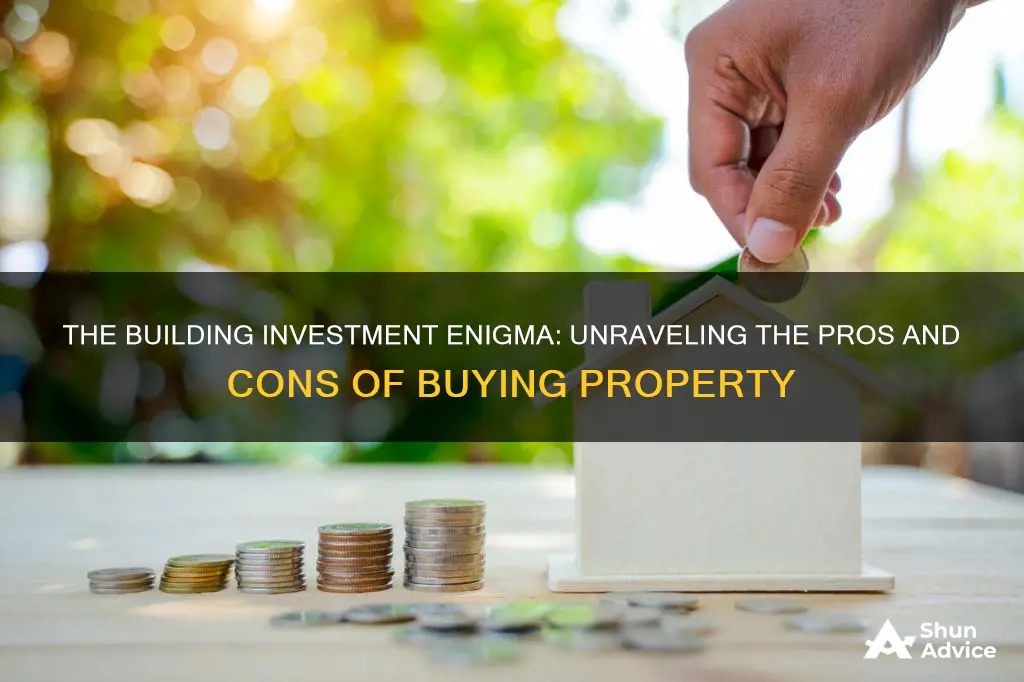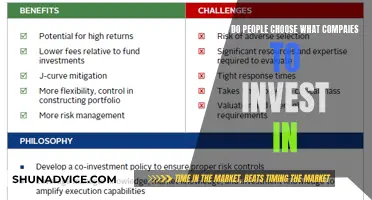
Buying a building is considered an investing activity. Investing activities refer to the cash flows from investing activities, which is one of the three main sections of the statement of cash flows. This section includes a company's cash inflows and outflows from the acquisition or disposal of long-term assets, such as property, plant, and equipment. A building purchase would fall under this category as it is a long-term asset acquisition. Therefore, the purchase of a building would be reported as a negative amount in the cash flows from investing activities section of the statement of cash flows, indicating a decrease in the company's cash flow.
| Characteristics | Values |
|---|---|
| Definition | Investing activities refer to the cash flows from investing activities, which is one of the three main sections of the statement of cash flows. |
| Types of Activities | Capital expenditures, lending money, and the sale of investment securities. |
| Examples | Purchase of fixed assets, purchase of investments such as stocks or securities, lending money, sale of fixed assets, sale of investment securities, collection of loans and insurance proceeds. |
| Importance | Investing activities are important because they show how a company is allocating cash for the long term. For example, a company may invest in fixed assets such as property, plant, and equipment to grow the business. |
What You'll Learn

Buildings as fixed assets
A fixed asset is a long-term tangible property that a company uses to operate its business. Fixed assets are used by companies to generate income over a long period. They are also known as noncurrent assets, which are not easily converted to cash within a year. They are subject to depreciation to account for the loss in value over time.
Buildings are a type of fixed asset. The cost of acquiring a building or the cost of constructing one is included in the buildings account. If the purchase price of a building includes the cost of land, a portion of the cost is allocated to the Land account, which is not depreciated.
When a company purchases a building, it is recorded as a fixed asset if it has a useful life of more than one year and exceeds the corporate capitalization limit. The capitalization limit is the amount of expenditure below which an item is recorded as an expense rather than an asset. For example, if the capitalization limit is $5,000, then expenditures of $4,999 or less are recorded as expenses.
The purchase of a building is considered an investing activity as it involves the acquisition of a long-term asset. Investing activities refer to the purchase and sale of long-term assets and other business investments within a specific reporting period. They are recorded on the cash flow statement, which provides an account of the cash used in operations, including investing activities.
The cash flow statement shows how much cash has been generated or spent on various investment-related activities, including the purchase of physical assets. A negative cash flow from investing activities may indicate that the company is investing in the long-term health of the company, such as through research and development.
In summary, buildings are classified as fixed assets due to their long-term nature and their role in generating income for the company. The acquisition of buildings is considered an investing activity as it involves the purchase of long-term assets, and it is recorded on the cash flow statement, which provides insights into the company's investment gains and losses.
Protecting Retirement: Strategies to Shield Investments from Trade War Fallout
You may want to see also

Buying buildings as an investing activity
Investing activities are one of the primary categories of net cash activities that businesses report on their cash flow statements. Investing activities in accounting refer to the purchase and sale of long-term assets and other business investments within a specific reporting period. These activities provide insights into the total investment gains and losses experienced by a company during a defined period.
Buildings as Fixed Assets
Buildings are considered fixed assets, which are property and equipment owned by a business and used to generate revenue. Fixed assets are less liquid than current assets and are not intended to be converted into cash within a year. Other examples of fixed assets include land, vehicles, and equipment.
When a business purchases a building, it is considered an investing activity as it involves the acquisition of a long-term asset. This transaction will result in a decrease in the company's cash flow from investing activities, indicating cash outflow from the business to cover the purchase cost.
On the other hand, if a company sells a building, it will result in an increase in cash flow from investing activities, even if the sale price is lower than the original purchase price. This is because the cash flow statement focuses on the cash generated or spent, rather than the gains or losses made on the transaction.
Importance of Investing Activities
Investing activities are crucial for understanding a company's financial health and future growth prospects. A negative cash flow from investing activities may indicate that the company is investing in capital assets, which could lead to increased earnings in the future. Therefore, investors and analysts should not solely rely on negative cash flow as an indicator of poor performance.
In summary, buying buildings is considered an investing activity as it involves the purchase or sale of a fixed asset, which impacts a company's cash flow and provides insights into its long-term investment strategies and future growth potential.
The Roth IRA Advantage: Why Retirees Should Consider This Investment Option
You may want to see also

Investing activity and cash flow
Investing activities and cash flow are closely linked concepts in business and accounting. Investing activities refer to the purchase and sale of long-term assets and other business investments within a specific reporting period. These activities are a crucial component of a company's cash flow statement, which presents an overview of the sources and uses of cash.
The cash flow statement is one of the major financial statements prepared by companies, and it bridges the gap between the income statement and the balance sheet. It is divided into three sections: operating activities, investing activities, and financing activities. Operating activities include the day-to-day business activities, such as cash received from sales and wages paid. Financing activities show the net cash flows involved in funding the company's operations, including bond offerings and debt repayment.
Investing activities, on the other hand, involve the purchase and sale of long-term assets, such as property, plant, and equipment (PPE), as well as investments in securities. When a company buys an investment, such as stocks or bonds, it leads to a decrease in cash flow from investing activities as cash flows out of the business. Conversely, when a company sells an investment, it results in an increase in cash flow from investing activities, even if a loss is incurred on the sale.
The purchase of fixed assets, such as buildings, land, and vehicles, typically shows up in the cash flow from investing activities section over time since these assets are usually purchased on credit. Each cash payment made towards the credit purchase will result in a decrease in cash flow from investing activities. Similarly, the sale of fixed assets leads to an increase in cash flow from investing activities, regardless of whether the asset is sold for a gain or a loss.
Analyzing the cash flow from investing activities is important as it provides insights into how a company is allocating its cash for the long term. A negative cash flow from investing activities might not always be a bad sign, as it could indicate that the company is investing in its future growth and long-term health. For example, a company with significant capital expenditures is often in a state of growth, investing in future operations. Therefore, investors and analysts should consider the investing activities section of the cash flow statement to understand a company's strategy and ability to generate profits in the future.
Nvidia: Buy or Bail?
You may want to see also

Buying a building vs. buying stocks
When it comes to investing, there are two main options: buying a building or buying stocks. Both options have their own set of advantages and disadvantages, and the best choice for an individual depends on their financial situation, risk tolerance, goals, and investment style. Here is an in-depth look at the pros and cons of each option:
Buying a Building
One of the main advantages of investing in real estate is that it provides a passive income stream and the potential for substantial appreciation. While it may require more upfront capital and time compared to investing in stocks, real estate investing is generally less volatile and can be a good hedge against inflation. Additionally, real estate investors can gain leverage on their capital and take advantage of substantial tax benefits. For example, investors can deduct the cost of maintenance, depreciation, mortgage interest, and property taxes from their taxable income.
On the other hand, real estate investing also comes with several downsides. It is important to consider the amount of money required for a down payment and financing, as well as the illiquid nature of real estate. Selling a property can be a time-intensive process, and there may be high transaction costs involved. Real estate also tends to be more work-intensive, as investors are responsible for repairs, maintenance, and managing tenants.
Buying Stocks
Investing in stocks has several benefits, including the ease of diversification and liquidity. With stocks, investors can quickly buy and sell through brokerage accounts, and it doesn't require a huge cash infusion to get started. Stocks are also highly liquid, meaning they can be easily converted to cash if needed. Additionally, stocks can be purchased through tax-advantaged retirement funds, providing tax-deferred or tax-free growth.
However, there are also some cons to consider when investing in stocks. Stocks tend to be more volatile than real estate, and individual stocks can fluctuate wildly in value, especially in the short term. Selling stocks may also result in capital gains taxes, and there is no guarantee of a direct use or benefit from owning stocks.
In conclusion, both buying a building and buying stocks have their advantages and disadvantages. The best option for an individual depends on their financial goals, risk tolerance, and personal preferences. It is important to carefully consider the pros and cons of each option before making an investment decision.
Theft of Investments: A Growing Concern
You may want to see also

Pros and cons of buying a building
Buying a building is an investing activity. It is the purchase of a long-term asset, which can provide insight into the total investment gains and losses experienced by a company during a defined period.
Pros of buying a building:
- Convenience and cost: Buying an existing building is often more convenient and cheaper than constructing a new one. The process is typically faster and involves less financial burden, as you don't have to worry about construction loans and other associated costs.
- Quick close: With an existing building, you can usually close the deal and move in within 30 to 45 days, avoiding the lengthy construction process.
- Room to negotiate: When buying an existing building, you often have the opportunity to negotiate the price and terms with the seller, which can result in cost savings.
- Location: The money saved by opting for an existing building can be allocated to securing a property in a desirable location, which is a crucial factor in real estate.
- Developed landscaping: Existing buildings are likely to have more mature landscaping, with trees, bushes, and flowers already in place, saving you the time and cost of developing a garden from scratch.
Cons of buying a building:
- Repairs and maintenance: Older buildings may require significant repairs and maintenance to meet current safety regulations and building codes. This can include replacing roofs, HVAC systems, electrical wiring, or plumbing.
- Compromises: It is unlikely that you will find an existing building that checks off every item on your wish list. You may have to settle for certain aspects that you don't like or compromise on your initial requirements.
- Updates: Existing buildings may have outdated designs, features, or finishes that need to be updated to meet your preferences and modern standards. This can result in additional costs and renovation work.
- Environmental concerns: Older buildings may contain harmful substances, such as lead paint or asbestos, which need to be safely removed or remediated.
- Hidden problems: Even with a thorough inspection, there is a risk of discovering hidden issues or problems that were missed during the inspection process.
Pros of buying land and constructing a building:
- Customization: When you build from scratch, you have a high degree of control over the design, layout, finishes, and other aspects of the building. This allows you to create a space that perfectly suits your needs and preferences.
- Low competition: Building your own structure eliminates the competition associated with bidding on existing buildings, especially in a hot real estate market.
- Energy efficiency: Modern construction often incorporates energy-efficient systems and appliances, which can result in significant savings on utility bills.
- Newness: With a newly constructed building, you start as the first occupant, ensuring that everything is brand new and reducing the likelihood of immediate repairs or maintenance issues.
Cons of buying land and constructing a building:
- Cost: Constructing a new building is typically more expensive than buying an existing one, and you may need to obtain multiple loans, such as land loans and construction loans, to finance the project.
- Time: The construction process can be lengthy, taking months or even years to complete due to factors like labor shortages and material delays.
- Stress: Building a new structure involves managing numerous details, staying within budget, and making countless decisions, which can be a stressful and time-consuming process.
- Noise and mess: Construction sites can be noisy and messy, and if you're building in an area with multiple ongoing projects, you may have to deal with construction traffic and other inconveniences.
- Hidden costs: Unexpected costs can arise during construction due to upgrades, unforeseen problems, or post-move expenses like landscaping and window treatments.
Whether you choose to buy an existing building or construct a new one, it is essential to carefully consider your specific needs, budget, and timeline to make an informed decision that aligns with your goals.
Dutch Investment Apathy
You may want to see also







